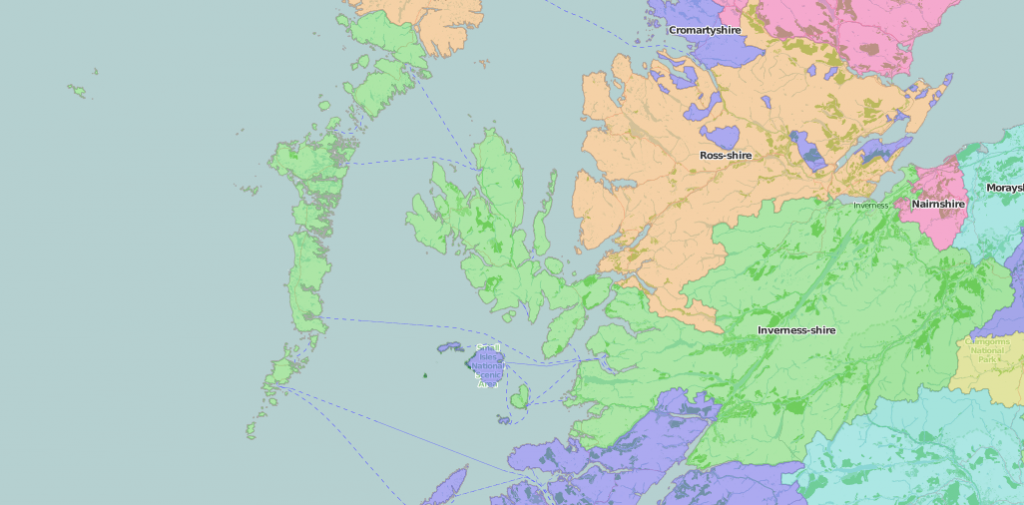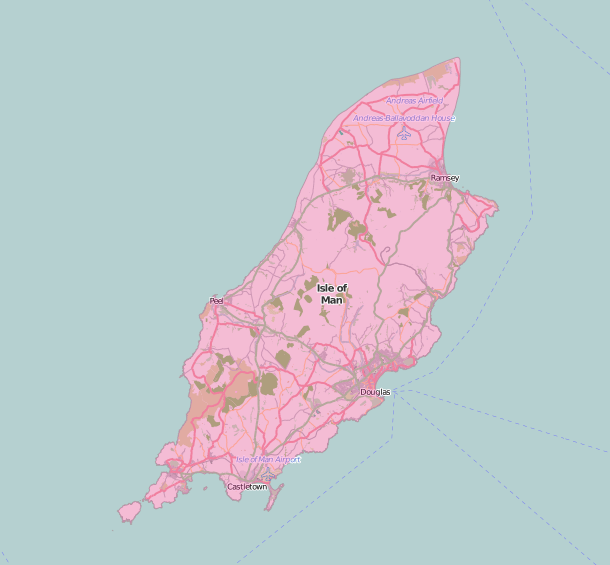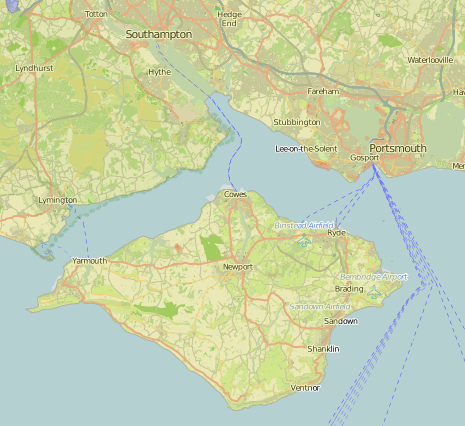
From (not quite) the most northerly island to (not quite) the most southerly, via the individuality of the Isle of Man.
Inverness-shire, Scotland’s largest county, stretches across much of the Highlands to the Inner (Skye) and Outer Hebrides (from Berneray up to Harris), including Eigg in the Small Isles. No wonder the surveyors of the General Views series for the Board of Agriculture included bits of the county in reports for Argyllshire, Elgin, and Nairn. Rev. James Robertson D.D., minister at Callander (died 1812), had already worked on the first Statistical Account of Scotland (1791-1799) and covered Perth (General Views 1794 and 1799) before embarking on his “fatiguing tour” for a “survey of such immense extent” in the Inverness volume (1808 and 1813). Robertson’s account frequently cites Gaelic names and terms, the Highlands and Islands being then as now the stronghold of Gaelic speakers.
Robertson’s survey might have proved less tiring a decade later, with the opening of the Caledonian canal in 1822. Guidebooks to the area were quick to flag it up: James Lumden’s Steam-boat Companion; and Stranger’s Guide to the Western Islands and Highlands of Scotland (1820) was updated to include the canal in the second edition of 1825. The geologist and surgeon John Macculloch (1773-1835) was another indefatiguable surveyor; his Description of the Western islands of Scotland, including the Isle of Man, comprising an account of their geological structure, with remarks on their agriculture, scenery and antiquities (1819) was based on his trigonometrical work for the ordnance survey.

Speed’s map of the Isle of Man shows the surrounding English, Welsh, Irish and Scottish coastlines, with a special central compass marked, and a separate scale to show the actual distance from these countries to the island. Ruled successively by Norway, Scotland (until the Scots were defeated at the battle of Neville’s Cross), and England, the island retained distinctive dress, language (Manx Gaelic), military and legal systems – the Earls of Derby, the Stanley family of Lancashire, were Lords of Man 1405-1736, but rare visitors. The bookplate of the 10th and last Earl to hold the Lordship, James Stanley (1664-1736) reads, “The Right Honble. James, Earl of Derby, Lord of Man and ye Isles, 1702” as you can see in many books from the library at Knowsley Hall; successive editions of John Seacome’s Memoirs of the house of Stanley included “a full description of the Isle of Man”.
The 18th and 19th century histories and guidebooks to the island in Special Collections show a changing focus from antiquarian histories through tours to guidebooks, up to the 20th century celebration of “the charms of Manxland” in the form of a Valentine & Sons photograph album “containing 57 views of Douglas, Laxey, Ramsey, Peel, Port Erin, Castletown, and the beautiful glens and waterfalls of the island”.
The Port Erin Marine Biological Station, established by Professor William Herdman in 1892, added to the island’s tourist attractions with its fish hatchery and aquarium. Its surveys of the marine life around the island, published by Liverpool University Press, included Microscopic life in the sea and Marine plankton (1924), Manx algae (1931), and Marine fauna of the Isle of Man (1937); the University Archive has records of the Station’s work. The Manx linguist, folklorist and activist Sophia Morrison (1859-1917) collected Manx creatures of a different kind in her Manx fairy tales (1911).

The Isle of Wight for Speed’s contemporaries was part of Hampshire, which explains why the map has a town plan of Southampton as well as of Newport. Navigational features include the sheer cliffs of the island’s south coast, offshore rocks and inshore windmills and beacons – some of which seem to tower over the windmills.
The island’s air is “commended for health and delight”, no doubt the benign influence of the sea breezes.
Would-be visitors to the Isle of Wight can find folklore, travel advice, and history in Special Collections, including contemporary pamphlets on Charles I’s enforced stay when he was imprisoned on the island at Carisbrooke Castle and Hurst Castle (16 November 1647–12 December 1648).
Isle of Wight authors include Richard Worsley (1751-1805), seventh baronet, art collector, antiquarian, and local MP. His History (1781) is in fact the culmination of work by three generations of the family. The Worsley house at Appuldurcombe, with its Capability Brown landscape, remains a tourist attraction in its own right. The house he built in the Undercliff is mentioned in Emma Marshall’s novel, A romance of the Undercliff; or, the Isle of Wight in 1799, one of the hundreds of domestic and historical tales through which she wrote her family out of poverty. William Gilpin’s series of Observations presented another version of the picturesque island in “a few remarks on the Isle of Wight” added to his 1798 volume on south-west England.
Special Collections classmarks of items cited:
Inverness
- Great Britain. Board of Agriculture. General view of the agriculture in the county of Inverness; with observations on the means of its improvement By J. Robertson (1808): SPEC Y80.3.478
- James Lumsden and Son, The steam-boat companion; and, Stranger’s guide to the Western Islands and Highlands of Scotland: comprehending the steam voyage from London to Leith, &c. A description of the scenery of Loch Lomond, Iona, Staffa, Skye, the Caledonian canal, and other places usually visited by strangers; and of the river and frith of Clyde; with the voyages to Liverpool and Belfast, and land tours to the Giant’s Causeway, and the lakes in Cumberland. Second edition, greatly enlarged and improved (1825): SPEC L2.3
- John Macculloch, A description of the Western islands of Scotland, including the Isle of Man, comprising an account of their geological structure, with remarks on their agriculture, scenery and antiquities (1819): SPEC EB.1.11/B
Isle of Man
- John Seacome, Memoirs; containing a genealogical and historical account of the … house of Stanley … to … 1735; as also a full description of the Isle of Man, &c. (Liverpool: Printed by A. Sadler, 1741): SPEC Y74.3.5
- William Sacheverell, Governor of the Isle of Man, An account of the Isle of Man, its inhabitants, language, soil … With a voyage to I-Columb-kill. To which is added, a dissertation about the Mona of Caesar and Tacitus; and an account of the ancient druids, &c by Mr. Thomas Brown. Address’d in a letter to … Mr. A. Sellars (1702): SPEC L4.17
- Richard Rolt, The history of the Island of Man; from the earliest accounts to the present time (1773): SPEC L2.38
- Richard Townley, A journal kept in the Isle of Man … for upwards of eleven months: with observations on the soil … antiquities … &c. Together with a large appendix: containing an account of the … government … under the noble house of Stanley … Together with .. notes (1791): SPEC L24.24
- John Feltham, A tour through the island of Mann, in 1797 and 1798 (1798): SPEC L14.15
- Nathaniel Jefferys, A descriptive and historical account of the Isle of Man; with a view of its society, manners, and customs; partly compiled from various authorities, and from observations made in a tour through the island, in the summer of 1808 (1809): SPEC L7.21
- George Woods, An account of the past and present state of the Isle of Man (1811): SPEC Y81.3.116
- Hannah Ann Bullock, History of the Isle of Man, with a comparative view of the past and present state of society and manners; containing also biographical anecdotes of eminent persons connected with that island (1816): SPEC Y81.3.114
- Samuel Haining, A historical sketch and descriptive view of the Isle and Man; designed as a companion to those who visit and make the tour of it (Douglas : Printed and sold by C. Jefferson, for the Author, sold also by Lane and Son; and J. Townsend, Ramsey, 1822): SPEC J24.58
- The Isle of Man guide for 1839, containing an historical sketch, and descriptive views of the island [By S.H.] (Douglas : W. Dillon etc., 1839): SPEC Y83.3.143
- Quiggin’s illustrated guide and visitor’s companion through the Isle of Man; with a directory for Douglas [With an account of the natural history of the island by E. Forbes.] (Douglas : Quiggin, 1839): SPEC Y83.3.156
- A New guide, and visitor’s companion, through the Isle of Man (Douglas, Duke St. and Parliament Street, Ramsey : William Cannell, 1843): SPEC Y84.3.95
- Joseph Train (1779-1852), An historical and statistical account of the Isle of Man, from the earliest times to the present date; with a view of its ancient laws, peculiar customs, and popular superstitions (Douglas : Quiggin, 1845): SPEC Y84.3.96
- Photographic view album illustrating some of the charms of Manxland : containing 57 views of Douglas, Laxey, Ramsey, Peel, Port Erin, Castletown, and the beautiful glens and waterfalls of the island (Dundee, Scotland : Valentine & Sons, [190-?]): SPEC Y90.3.398.
- Port Erin Marine Biological Station (Isle of Man, England), Microscopic life in the sea (1924): SPEC LUP.924.UNI(PC)
- James Johnstone (1870-1932), The marine plankton; with special reference to investigations made at Port Erin, Isle of Man, during 1907-1914 (1924): SPEC LUP.924.JOH
- Margery Knight, Manx algae: an algal survey of the south end of the Isle of Man (1931): SPEC LUP.931.KNI
- Hilary B. Moore, Marine fauna of the Isle of Man (1937): SPEC LUP.937.MOO
- Sophia Morrison, Manx fairy tales (1911): Oldham 584
Isle of Wight
- A designe by Captain Barley, : and others, to surprize Carisbrook Castle, in the Isle of Wyght, where His Majesty now is. With the proceedings of Colonel Hammond against them, Captain Barley, and some others of the chief actors taken prisoners, who are to be tryed for their lives by Martiall Law. Also some proceedings in Parliament, concerning the King. (who is in Carisbrook Castle) for the security of his person. January 1. 1647. (1648): SPEC Knows. pamph 473(23)
- A message sent from the city of London, to the King Majesty in the Isle of Wight, : declaring their resolutions touching the speedy bringing of His Majesty to His royall palace at White-Hall, and the manner thereof. Subscribed by the royall-hearted citizens. Also, the declaration of the Queen of England, concerning Her royall consort King Charles; and Her letter to the Prince of Wales, touching the Earl of Warwick. Agreed upon by the Queens Maiesty, and Her councell at St. Jermins, and published throughout the Kingdome of France (1648): SPEC Knows.pamph 445 (45)
- Alice E. Gillington, Old Isle of Wight singing games (19–?): SPEC Scott Macfie A.7.50(5)
- Jacob Abbott (1803-1879), A visit to the Isle of Wight By the author of ‘Pierre and his family’ (Philadelphia : American Sunday-School Union, 1828): JUV.450:88
- Old Humphrey, 1787-1854, Wanderings in the Isle of Wight by the author of ‘The old sea-captain‘ [i.e. George Mogridge] (1846): SPEC Y84.3.142
- Emma Marshall (1828-1899), A romance of the Undercliff; or, The Isle of Wight in 1799 (1895): JUV.A258:66
- John Albin, A companion to the Isle of Wight: comprising the history of the island and the description of its scenery (1818): SPEC J15.7(2)
- Wiliam Gilpin (1724-1804), Observations on the western parts of England, chiefly relative to picturesque beauty, to which are added, a few remarks on the Isle of Wight (1798): SPEC Y79.3.551
- Richard Warner (1763-1857), The history of the Isle of Wight; military, ecclesiastical, civil, & natural; to which is added, A view of its agriculture (1795): SPEC L51.21
- Sir Richard Worsley, (1751-1805), The history of the Isle of Wight (1781): SPEC Y78.5.22